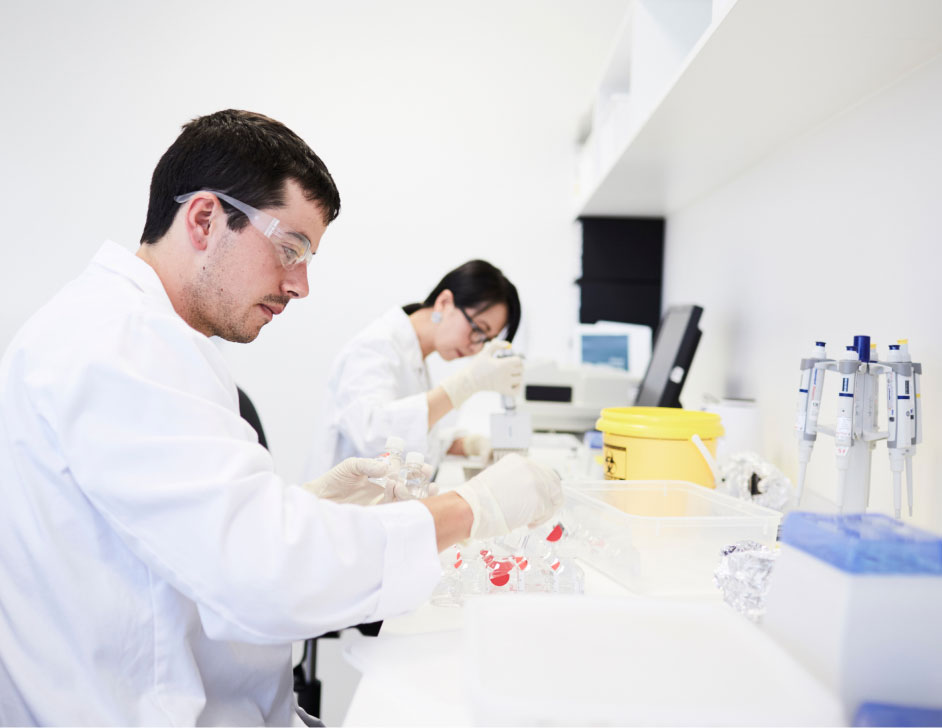Are You a Healthcare Professional?
This European website, initiated and developed by CSL Behring, has two separate sections with the aim to provide information on haemophilia for an international audience, either to European healthcare professionals or to the general public.*
Yes, I am a healthcare professional*
No, I am not a healthcare professional
Every Step Has Been Evolving The Science Of Gene Therapy In Haemophilia
Treatments for haemophilia are constantly being developed to improve the Quality of Life for people with haemophilia and their caregivers. Throughout this site you can learn more about haemophilia, current treatments and explore the science behind gene therapy in haemophilia.

Did you know?
On average, how many bleeds per year can a person living with severe haemophilia experience?
3,0 – 4,9
In a retrospective study using data from haemophilia patient diaries from the Austrian Hemophilia Registry in 2012 to 2017, patients on prophylaxis with haemophilia A and B had annualised bleeding rates (ABRs) of 4,9 and 3,0, respectively.7
Which percentage of patients with haemophilia experienced bodily pain associated with their mild or severe haemophilia?
90%
Majority of patients experienced bodily pain over the 4-week assessment period. The pain was severe for 10% and moderate for 34%.8
What proportion of patients do not adhere to their prescribed treatment regimen?
73%
In a global survey, nearly three quarters of patients said they do not adhere to their prescribed treatment as directed, citing problems with traveling to treatment centres (72%), cost of treatment (69%) and lack of supply (55%).9

Living With Haemophilia
Management Strategies for Haemophilia Have Come a Long Way and There is Still Room for Improvement
Recent scientific advancements have revolutionized available treatments, however, there is still more that can be done to ensure patients are living the highest quality life.

Recent Treatment Developments for Haemophilia
How have treatment options for patients with haemophilia advanced over the years and what options are currently available?
References
- Morfini M. The history of clotting factor concentrates pharmacokinetics. J Clin Med. 2017;6,35.
- European Medicines Agency (EMA). BeneFIX. https://www.ema.europa.eu/en/medicines/human/EPAR/benefix. Accessed November 30, 2021.
- Kay MA, Manno CS, Ragni MV, et al. Evidence for gene transfer and expression of factor IX in haemophilia B patients treated with an AAV vector. Nat Genet. 2000;24(3):257–61.
- European Medicines Agency (EMA). Roctavian. https://www.ema.europa.eu/en/medicines/human/EPAR/roctavian-0. Accessed January 28, 2023.
- FDA Approves First Gene Therapy to Treat Adults with Hemophilia B [press release]. Silver Spring, Maryland, USA: US Food and Drug Administration (FDA). https://www.fda.gov/news-events/press-announcements/fda-approves-first-gene-therapy-treat-adults-hemophilia-b. November 22, 2022. Accessed January 5, 2023.
- European Medicines Agency (EMA). Hemgenix. https://www.ema.europa.eu/en/medicines/human/EPAR/hemgenix. Accessed July 14, 2023.
- Ay C, Perschy L, Rejtö J, Kaider A, Pabinger I. Treatment patterns and bleeding outcomes in persons with severe hemophilia A and B in a real-world setting. Ann Hematol. 2020;99:2763-2771.
- Buckner TW, Batt K, Quon D, et al. Assessments of pain, functional impairment, anxiety, and depression in US adults with hemophilia across patient-reported outcome instruments in the Pain, Functional Impairment, and Quality of Life (P-FiQ) study. Eur J Haemotol. 2018;100(suppl. 1):5-13.
- Witkop M, Guelcher C, Forsyth A, et al. Treatment outcomes, quality of life, and impacts of hemophilia on young adults (aged 18-30 years) with hemophilia. Am J Hematol. 2015;90(S2):S3-S10.
- Srivastava A, Santagostino E, Dougall A, et al. WFH guideline for the management of hemophilia, 3rd edition. Haemophilia. 2020;00:1-158.
- Anguela XM, High KA. Entering the modern era of gene therapy. Annu Rev Med. 2019;70:273-288.
- European Medicines Agency. Luxturna. https://www.ema.europa.eu/en/medicines/human/EPAR/luxturna. Accessed November 5, 2021.
- European Medicines Agency. Zolgensma. https://www.ema.europa.eu/en/medicines/human/EPAR/zolgensma. Accessed November 5, 2021.
- Food and Drug Administration. Approved Cellular and Gene Therapy Products. https://www.fda.gov/vaccines-blood-biologics/cellular-gene-therapy-products/approved-cellular-and-gene-therapy-products. Accessed November 5, 2021.




